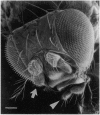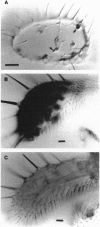Abstract
A central problem in sensory system biology is the identification of the signal transduction pathways used in different sensory modalities. Genetic analysis of transduction mutants provides a means of studying in vivo the contributions of different pathways. This report shows that odorant response in one olfactory organ of Drosophila melanogaster depends on the norpA phospholipase C (EC 3.1.4.3) gene, providing evidence for use of the inositol 1,4,5-trisphosphate (IP3) signal transduction pathway. Since the norpA gene is also essential to phototransduction, this work demonstrates overlap in the genetic and molecular underpinnings of vision and olfaction. Genetic and molecular data also indicate that some olfactory information flows through a pathway which does not depend on norpA.
Full text
PDF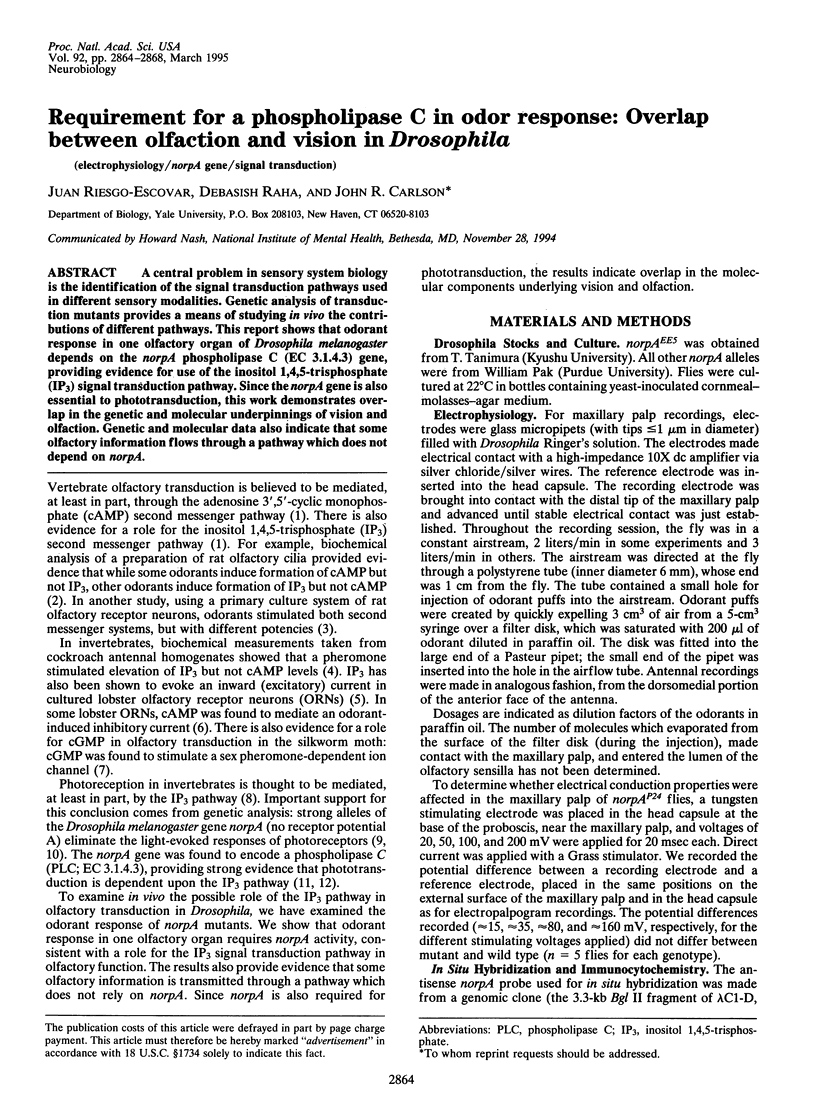
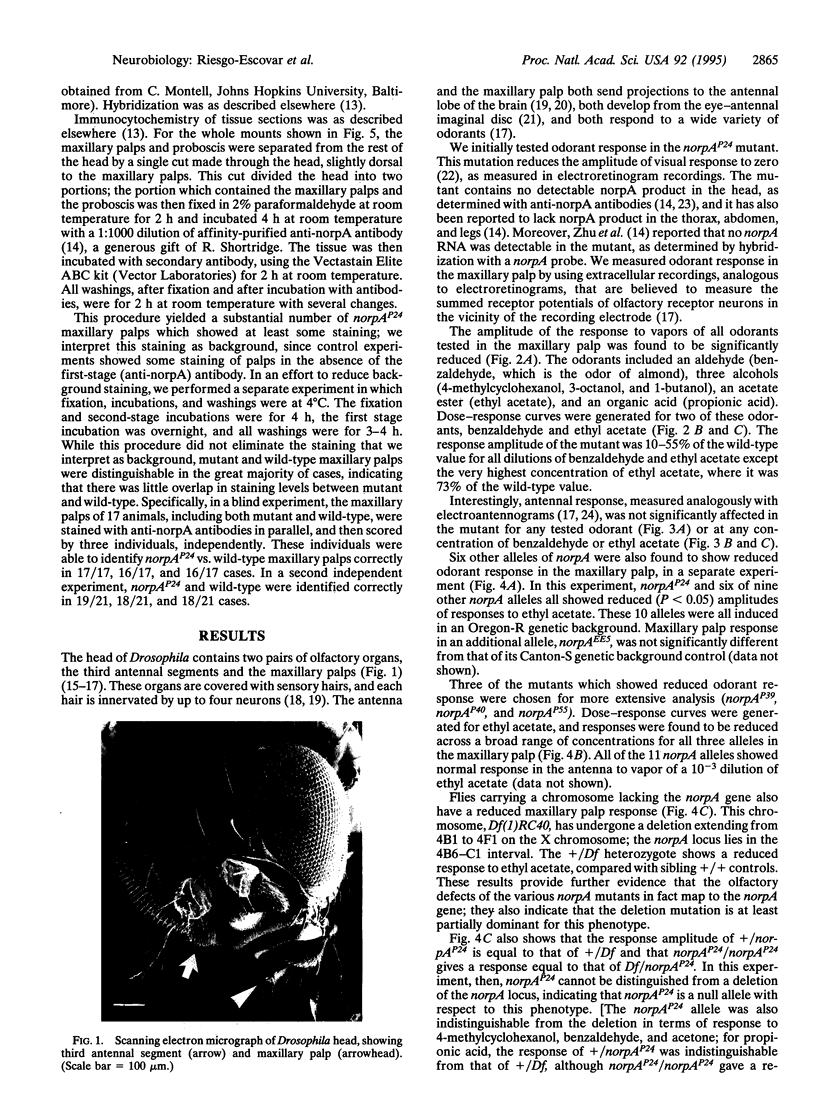
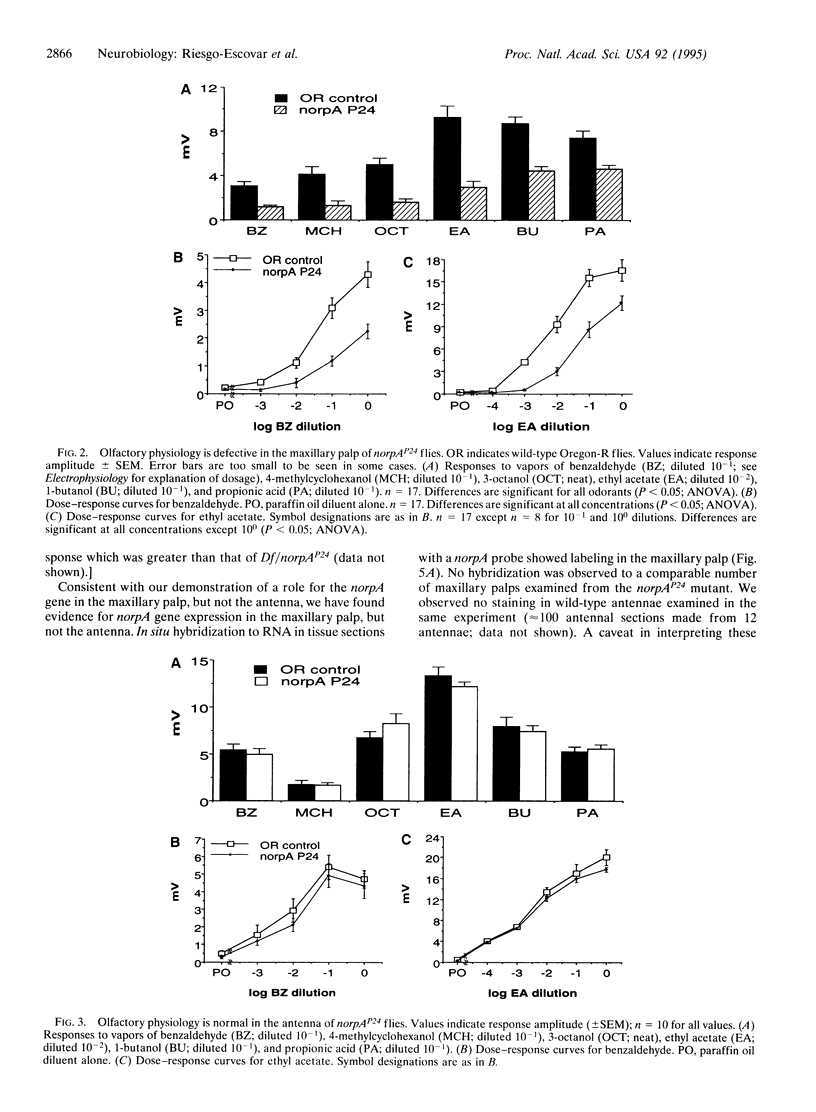
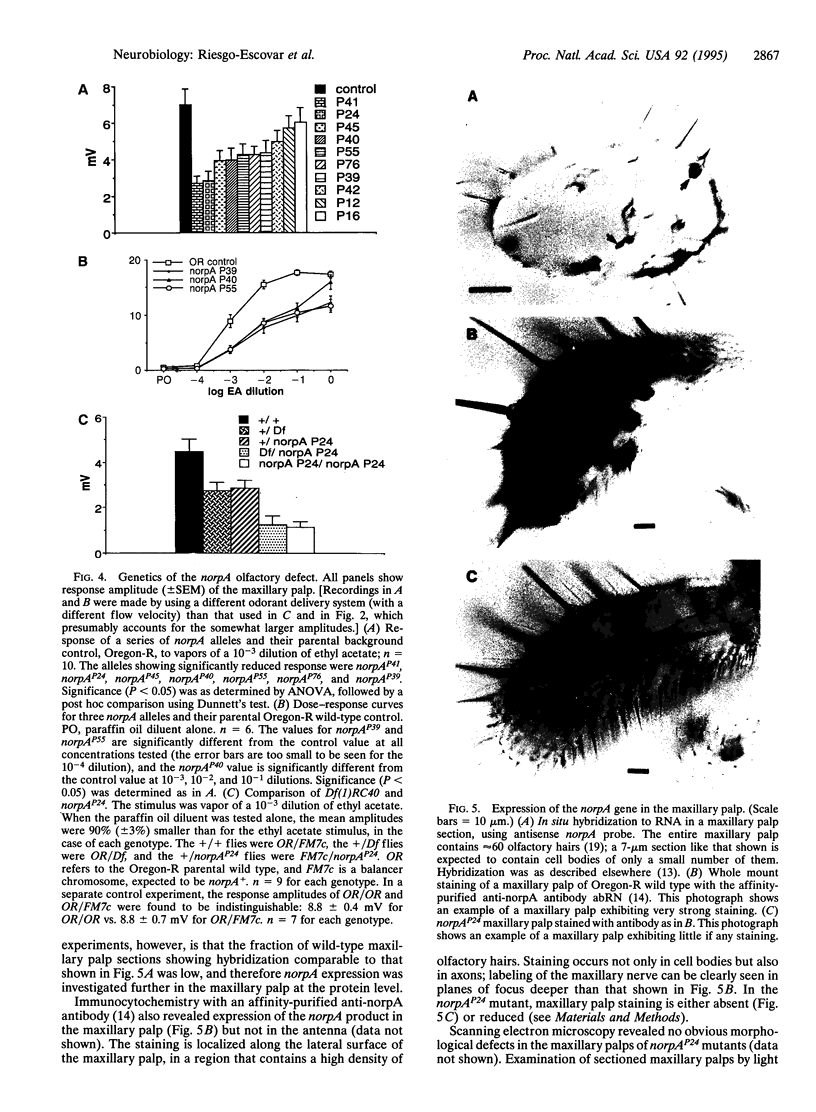
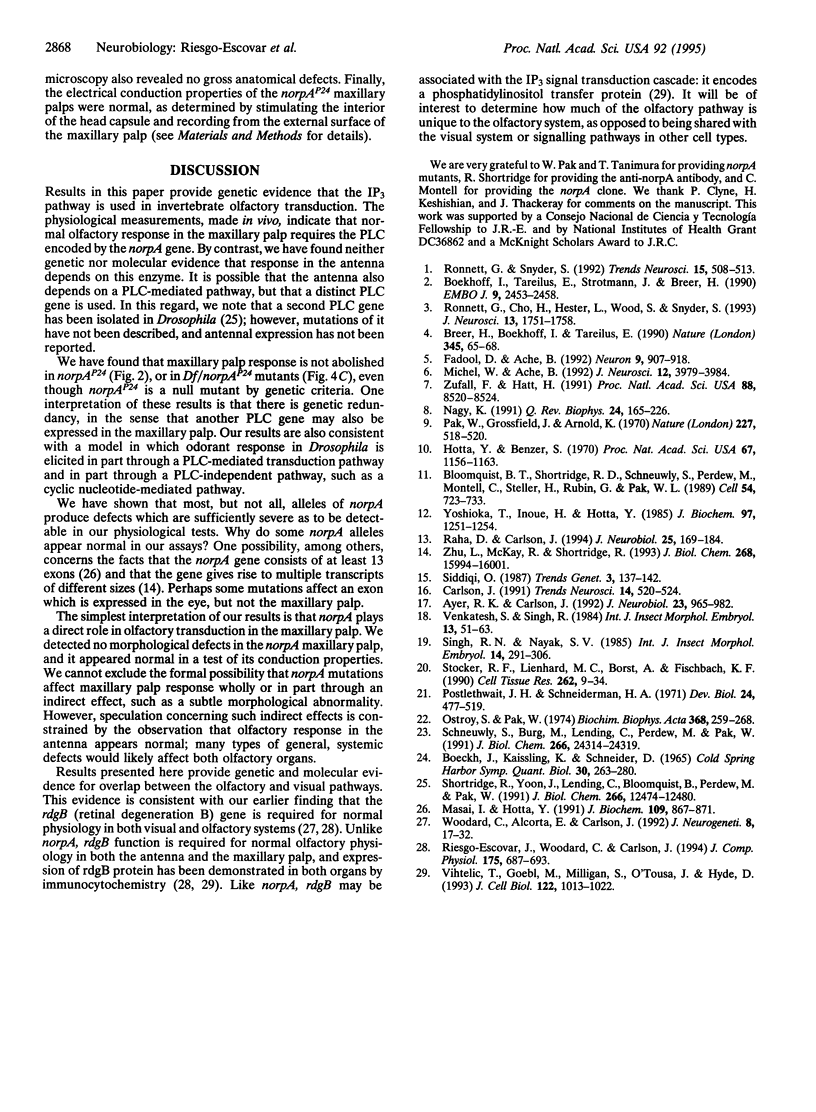
Images in this article
Selected References
These references are in PubMed. This may not be the complete list of references from this article.
- Ayer R. K., Jr, Carlson J. Olfactory physiology in the Drosophila antenna and maxillary palp: acj6 distinguishes two classes of odorant pathways. J Neurobiol. 1992 Oct;23(8):965–982. doi: 10.1002/neu.480230804. [DOI] [PubMed] [Google Scholar]
- Bloomquist B. T., Shortridge R. D., Schneuwly S., Perdew M., Montell C., Steller H., Rubin G., Pak W. L. Isolation of a putative phospholipase C gene of Drosophila, norpA, and its role in phototransduction. Cell. 1988 Aug 26;54(5):723–733. doi: 10.1016/s0092-8674(88)80017-5. [DOI] [PubMed] [Google Scholar]
- Boeckh J., Kaissling K. E., Schneider D. Insect olfactory receptors. Cold Spring Harb Symp Quant Biol. 1965;30:263–280. doi: 10.1101/sqb.1965.030.01.028. [DOI] [PubMed] [Google Scholar]
- Boekhoff I., Tareilus E., Strotmann J., Breer H. Rapid activation of alternative second messenger pathways in olfactory cilia from rats by different odorants. EMBO J. 1990 Aug;9(8):2453–2458. doi: 10.1002/j.1460-2075.1990.tb07422.x. [DOI] [PMC free article] [PubMed] [Google Scholar]
- Breer H., Boekhoff I., Tareilus E. Rapid kinetics of second messenger formation in olfactory transduction. Nature. 1990 May 3;345(6270):65–68. doi: 10.1038/345065a0. [DOI] [PubMed] [Google Scholar]
- Carlson J. Olfaction in Drosophila: genetic and molecular analysis. Trends Neurosci. 1991 Dec;14(12):520–524. doi: 10.1016/0166-2236(91)90004-e. [DOI] [PubMed] [Google Scholar]
- Fadool D. A., Ache B. W. Plasma membrane inositol 1,4,5-trisphosphate-activated channels mediate signal transduction in lobster olfactory receptor neurons. Neuron. 1992 Nov;9(5):907–918. doi: 10.1016/0896-6273(92)90243-7. [DOI] [PMC free article] [PubMed] [Google Scholar]
- Hotta Y., Benzer S. Genetic dissection of the Drosophila nervous system by means of mosaics. Proc Natl Acad Sci U S A. 1970 Nov;67(3):1156–1163. doi: 10.1073/pnas.67.3.1156. [DOI] [PMC free article] [PubMed] [Google Scholar]
- Masai I., Hotta Y. Genomic organization of a Drosophila phospholipase C, norpA, and molecular lesions in two temperature-sensitive mutants. J Biochem. 1991 Jun;109(6):867–871. doi: 10.1093/oxfordjournals.jbchem.a123472. [DOI] [PubMed] [Google Scholar]
- Michel W. C., Ache B. W. Cyclic nucleotides mediate an odor-evoked potassium conductance in lobster olfactory receptor cells. J Neurosci. 1992 Oct;12(10):3979–3984. doi: 10.1523/JNEUROSCI.12-10-03979.1992. [DOI] [PMC free article] [PubMed] [Google Scholar]
- Nagy K. Biophysical processes in invertebrate photoreceptors: recent progress and a critical overview based on Limulus photoreceptors. Q Rev Biophys. 1991 May;24(2):165–226. doi: 10.1017/s0033583500003401. [DOI] [PubMed] [Google Scholar]
- Ostroy S. E., Pak W. L. Protein and electroretinogram changes in the alleles of the norp AP12 Drosophila phototransduction mutant. Biochim Biophys Acta. 1974 Nov 19;368(2):259–268. doi: 10.1016/0005-2728(74)90154-6. [DOI] [PubMed] [Google Scholar]
- Pak W. L., Grossfield J., Arnold K. S. Mutants of the visual pathway of Drosophila melanogaster. Nature. 1970 Aug 1;227(5257):518–520. doi: 10.1038/227518b0. [DOI] [PubMed] [Google Scholar]
- Postlethwait J. H., Schneiderman H. A. A clonal analysis of development in Drosophila melanogaster: morphogenesis, determination, and growth in the wild-type antenna. Dev Biol. 1971 Apr;24(4):477–519. doi: 10.1016/0012-1606(71)90061-3. [DOI] [PubMed] [Google Scholar]
- Raha D., Carlson J. OS9: a novel olfactory gene of Drosophila expressed in two olfactory organs. J Neurobiol. 1994 Feb;25(2):169–184. doi: 10.1002/neu.480250208. [DOI] [PubMed] [Google Scholar]
- Riesgo-Escovar J. R., Woodard C., Carlson J. R. Olfactory physiology in the Drosophila maxillary palp requires the visual system gene rdgB. J Comp Physiol A. 1994 Dec;175(6):687–693. doi: 10.1007/BF00191841. [DOI] [PubMed] [Google Scholar]
- Ronnett G. V., Cho H., Hester L. D., Wood S. F., Snyder S. H. Odorants differentially enhance phosphoinositide turnover and adenylyl cyclase in olfactory receptor neuronal cultures. J Neurosci. 1993 Apr;13(4):1751–1758. doi: 10.1523/JNEUROSCI.13-04-01751.1993. [DOI] [PMC free article] [PubMed] [Google Scholar]
- Ronnett G. V., Snyder S. H. Molecular messengers of olfaction. Trends Neurosci. 1992 Dec;15(12):508–513. doi: 10.1016/0166-2236(92)90104-g. [DOI] [PubMed] [Google Scholar]
- Schneuwly S., Burg M. G., Lending C., Perdew M. H., Pak W. L. Properties of photoreceptor-specific phospholipase C encoded by the norpA gene of Drosophila melanogaster. J Biol Chem. 1991 Dec 25;266(36):24314–24319. [PubMed] [Google Scholar]
- Shortridge R. D., Yoon J., Lending C. R., Bloomquist B. T., Perdew M. H., Pak W. L. A Drosophila phospholipase C gene that is expressed in the central nervous system. J Biol Chem. 1991 Jul 5;266(19):12474–12480. [PubMed] [Google Scholar]
- Stocker R. F., Lienhard M. C., Borst A., Fischbach K. F. Neuronal architecture of the antennal lobe in Drosophila melanogaster. Cell Tissue Res. 1990 Oct;262(1):9–34. doi: 10.1007/BF00327741. [DOI] [PubMed] [Google Scholar]
- Vihtelic T. S., Goebl M., Milligan S., O'Tousa J. E., Hyde D. R. Localization of Drosophila retinal degeneration B, a membrane-associated phosphatidylinositol transfer protein. J Cell Biol. 1993 Sep;122(5):1013–1022. doi: 10.1083/jcb.122.5.1013. [DOI] [PMC free article] [PubMed] [Google Scholar]
- Woodard C., Alcorta E., Carlson J. The rdgB gene of Drosophila: a link between vision and olfaction. J Neurogenet. 1992 Feb;8(1):17–31. doi: 10.3109/01677069209167269. [DOI] [PubMed] [Google Scholar]
- Yoshioka T., Inoue H., Hotta Y. Absence of phosphatidylinositol phosphodiesterase in the head of a Drosophila visual mutant, norpA (no receptor potential A). J Biochem. 1985 Apr;97(4):1251–1254. doi: 10.1093/oxfordjournals.jbchem.a135171. [DOI] [PubMed] [Google Scholar]
- Zhu L., McKay R. R., Shortridge R. D. Tissue-specific expression of phospholipase C encoded by the norpA gene of Drosophila melanogaster. J Biol Chem. 1993 Jul 25;268(21):15994–16001. [PubMed] [Google Scholar]
- Zufall F., Hatt H. Dual activation of a sex pheromone-dependent ion channel from insect olfactory dendrites by protein kinase C activators and cyclic GMP. Proc Natl Acad Sci U S A. 1991 Oct 1;88(19):8520–8524. doi: 10.1073/pnas.88.19.8520. [DOI] [PMC free article] [PubMed] [Google Scholar]



